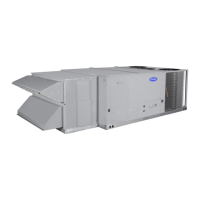22
OPERATION
Sequence of Operation
When free cooling is not available, the compressors will be
controlled by the zone thermostat. When free cooling is available,
the outdoor-air damper is modulated by the EconoMi$er IV
control to provide a 50°F to 55°F supply-air temperature into the
zone. As the supply-air temperature fluctuates above 55°F or
below 50°F, the dampers will be modulated (open or close) to
bring the Supply-air temperature back within the set points. For
EconoMi$er IV operation, there must be a thermostat call for the
fan (G). This will move the damper to its minimum position
during the occupied mode.
Above 50°F supply-air temperature, the dampers will modulate
from 100% open to the minimum open position. From 50°F to
45°F supply-air temperature, the dampers will maintain at the
minimum open position. Below 45°F, the dampers will be
completely shut. As the supply-air temperature rises, the dampers
will come back open to the minimum open position once the
supply-air temperature rises to 48°F.
If optional power exhaust is installed, as the outdoor-air damper
opens and closes, the power exhaust fans will be energized and
de-energized.
If field-installed accessory CO
2
sensors are connected to the
EconoMi$er IV control, a demand controlled ventilation strategy
will begin to operate. As the CO
2
level in the zone increases above
the CO
2
set point, the minimum position of the damper will be
increased proportionally. As the CO
2
level decreases because of
the increase in fresh air, the outdoor-air damper will be
proportionally closed. Damper position will follow the higher
demand condition from DCV mode or free cooling mode.
Damper movement from full closed to full open (or vice versa)
will take between 1-1/2 and 2-1/2 minutes.
If free cooling can be used as determined from the appropriate
changeover command (dry bulb, enthalpy curve, or differential
enthalpy), a call for cooling (Y1 closes at the thermostat) will
cause the control to modulate the dampers open to maintain the
supply air temperature set point at 50°F to 55°F.
As the supply air temperature drops below the set point range of
50°F to 55°F, the control will modulate the outdoor-air dampers
closed to maintain the proper supply-air temperature.
TROUBLESHOOTING
See Table 6 on page 24 for EconoMi$er IV system logic.
EconoMi$er IV System Preparation
This procedure is used to prepare the EconoMi$er IV controller
for troubleshooting. No troubleshooting or testing is done by
performing the following procedure.
NOTE: This procedure requires a 9-v battery, 1.2 kilo-ohm
resistor, and a 5.6 kilo-ohm resistor which are not supplied with
the EconoMi$er IV controller.
1. Disconnect power at TR and TR1. All LEDs should be off.
Exhaust fan contact should be open.
2. Disconnect device at P and P1.
3. Jumper P to P1.
4. Disconnect wires at T and T1. Place 5.6 kilo-ohm resistor
across T and T1.
5. Jumper TR to 1.
6. Jumper TR to N.
7. If connected, remove sensor from terminals SO and +.
Connect 1.2 kilo-ohm checkout resistor across terminals
SO and +.
8. Put 620-ohm resistor across terminals SR and +.
9. Set minimum position, DCV set point, and exhaust
potentiometers fully CCW (counterclockwise).
10. Set DCV maximum position potentiometer fully CW
(clockwise).
11. Set enthalpy potentiometer to D.
12. Apply power (24 vac) to terminals TR and TR1.
Differential Enthalpy
To check differential enthalpy:
1. Make sure EconoMi$er IV system preparation procedure has
been performed.
2. Place 620-ohm resistor across SO and +.
3. Place 1.2 kilo-ohm resistor across SR and +. The Free Cool
LED should be lit.
4. Remove 620-ohm resistor across SO and +. The Free Cool
LED should turn off.
5. Return EconoMi$er IV settings and wiring to normal after
completing troubleshooting.
Single Enthalpy
To check single enthalpy:
1. Make sure the EconoMi$er IV system preparation procedure
has been performed.
2. Set the enthalpy potentiometer to A (fully CCW). The Free
Cool LED should be lit.
3. Set the enthalpy potentiometer to D (fully CW). The Free
Cool LED should turn off.
4. Return EconoMi$er IV system settings and wiring to normal
after completing troubleshooting.
DCV (Demand Controlled Ventilation) and Power
Exhaust
1. Make sure EconoMi$er IV preparation procedure has been
performed.
2. Ensure terminals AQ and AQ1 are open. The LED for both
DCV and Exhaust should be off. The actuator should be fully
closed.
3. Connect a 9-v battery to AQ (positive node) and AQ1
(negative node). The LED for both DCV and Exhaust should
turn on. The actuator should drive to between 90 and 95%
open.
4. Turn the Exhaust potentiometer CW until the Exhaust LED
turns off. The LED should turn off when the potentiometer is
approximately 90%. The actuator should remain in position.
5. Turn the DCV set point potentiometer CW until the DCV
LED turns off. The DCV LED should turn off when the
potentiometer is approximately 9-v. The actuator should drive
fully closed.
6. Turn the DCV and Exhaust potentiometers CCW until the
Exhaust LED turns on. The exhaust contact will close 30 to
120 seconds after the Exhaust LED turns on.
7. Return EconoMi$er IV settings and wiring to normal after
completing troubleshooting.
IMPORTANT: Be sure to record the positions of all
potentiometers before starting troubleshooting.

